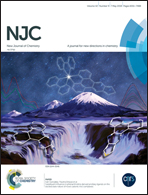Analysis of the surface decoration of TiO2 grains using silver nanoparticles obtained by ultrasonochemical synthesis towards organic photovoltaics
Abstract
In this article, we present a wet ultrasonochemical synthesis of nanocrystalline TiO2 powders in the anatase form in ethanol solution and their surface decoration using uniformly dispersed Ag metallic nanoparticles of about 4 nm at concentration of n = 0.5 to 2.5 wt% and those of 10–20 nm larger at a higher concentration than 1 wt%. The structure of the prepared composites was characterized using X-ray diffraction (XRD), transmission electron microscopy (TEM), atomic force microscopy (AFM), Raman and X-ray photoelectron spectroscopy (XPS). Optical properties were determined using UV-vis spectroscopy. Six polymer solar cells with modification by an TiO2/n-Ag hole transporting layer were manufactured and studied under AM 1.5G-simulated solar illumination (100 mW cm−2). The best performance was obtained for a device with the ITO/(PEDOT:PSS):1.5%Ag in TiO2/P3HT:PCBM/Al architectures. Under these conditions, a PCE of 2.07% with open circuit voltage Voc = 0.612 V, short circuit current density Jsc = 5.94 mA cm−2, and fill factor FF = 0.57 was achieved. Additionally, devices were tested by electrochemical impedance spectroscopy under illumination and a well-fitted equivalent circuit was proposed. Finally, our idea of the linkage of TiO2/n-Ag with PEDOT:PSS and P3HT in the constructed devices taking into account the amount of Ag in TiO2 was proposed.



 Please wait while we load your content...
Please wait while we load your content...